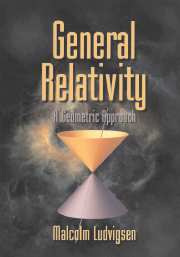Refine listing
Actions for selected content:
16950 results
4 - Basics of cosmological perturbation theory
-
- Book:
- Dark Energy
- Published online:
- 05 March 2013
- Print publication:
- 10 June 2010, pp 40-83
-
- Chapter
- Export citation
17 - Mathematical Appendix
-
- Book:
- Dark Energy
- Published online:
- 05 March 2013
- Print publication:
- 10 June 2010, pp 455-456
-
- Chapter
- Export citation
10 - Cosmic acceleration without dark energy
-
- Book:
- Dark Energy
- Published online:
- 05 March 2013
- Print publication:
- 10 June 2010, pp 285-295
-
- Chapter
- Export citation
Preface
-
- Book:
- Dark Energy
- Published online:
- 05 March 2013
- Print publication:
- 10 June 2010, pp ix-xii
-
- Chapter
- Export citation

General Relativity
- A Geometric Approach
-
- Published online:
- 04 June 2010
- Print publication:
- 28 May 1999
2 - Uncertainty
-
- Book:
- To Measure the Sky
- Published online:
- 05 June 2012
- Print publication:
- 27 May 2010, pp 35-59
-
- Chapter
- Export citation
4 - Names, catalogs, and databases
-
- Book:
- To Measure the Sky
- Published online:
- 05 June 2012
- Print publication:
- 27 May 2010, pp 98-117
-
- Chapter
- Export citation
References
-
- Book:
- To Measure the Sky
- Published online:
- 05 June 2012
- Print publication:
- 27 May 2010, pp 437-440
-
- Chapter
- Export citation
10 - Photometry
-
- Book:
- To Measure the Sky
- Published online:
- 05 June 2012
- Print publication:
- 27 May 2010, pp 323-367
-
- Chapter
- Export citation
Preface
-
- Book:
- To Measure the Sky
- Published online:
- 05 June 2012
- Print publication:
- 27 May 2010, pp xi-xiv
-
- Chapter
- Export citation
7 - Matter and light
-
- Book:
- To Measure the Sky
- Published online:
- 05 June 2012
- Print publication:
- 27 May 2010, pp 196-234
-
- Chapter
- Export citation
Appendices
-
- Book:
- To Measure the Sky
- Published online:
- 05 June 2012
- Print publication:
- 27 May 2010, pp 407-436
-
- Chapter
- Export citation
11 - Spectrometers
-
- Book:
- To Measure the Sky
- Published online:
- 05 June 2012
- Print publication:
- 27 May 2010, pp 368-406
-
- Chapter
- Export citation
1 - Light
-
- Book:
- To Measure the Sky
- Published online:
- 05 June 2012
- Print publication:
- 27 May 2010, pp 1-34
-
- Chapter
- Export citation
Contents
-
- Book:
- To Measure the Sky
- Published online:
- 05 June 2012
- Print publication:
- 27 May 2010, pp vii-x
-
- Chapter
- Export citation
9 - Digital images from arrays
-
- Book:
- To Measure the Sky
- Published online:
- 05 June 2012
- Print publication:
- 27 May 2010, pp 275-322
-
- Chapter
- Export citation
3 - Place, time, and motion
-
- Book:
- To Measure the Sky
- Published online:
- 05 June 2012
- Print publication:
- 27 May 2010, pp 60-97
-
- Chapter
- Export citation
Frontmatter
-
- Book:
- To Measure the Sky
- Published online:
- 05 June 2012
- Print publication:
- 27 May 2010, pp i-vi
-
- Chapter
- Export citation
8 - Detectors
-
- Book:
- To Measure the Sky
- Published online:
- 05 June 2012
- Print publication:
- 27 May 2010, pp 235-274
-
- Chapter
- Export citation
6 - Astronomical telescopes
-
- Book:
- To Measure the Sky
- Published online:
- 05 June 2012
- Print publication:
- 27 May 2010, pp 157-195
-
- Chapter
- Export citation
